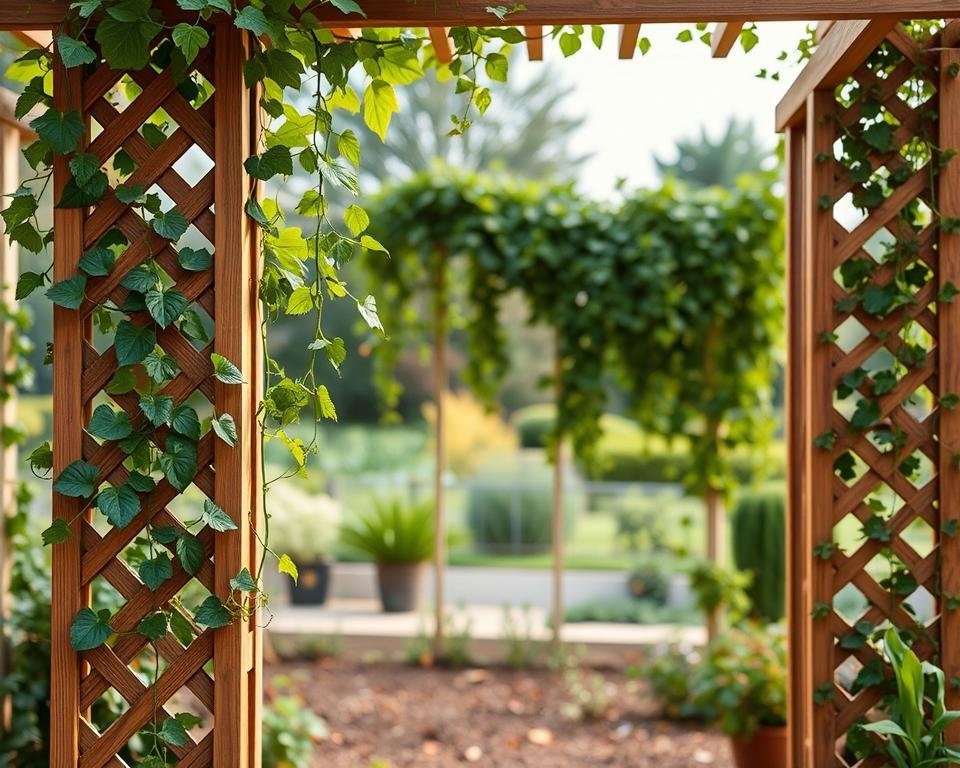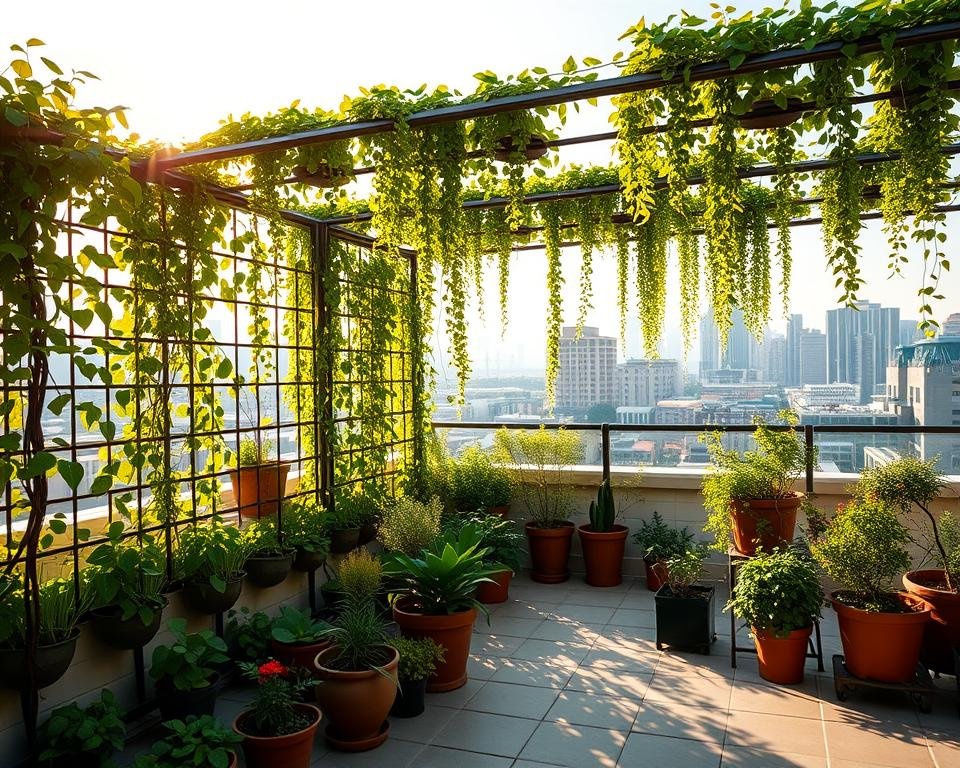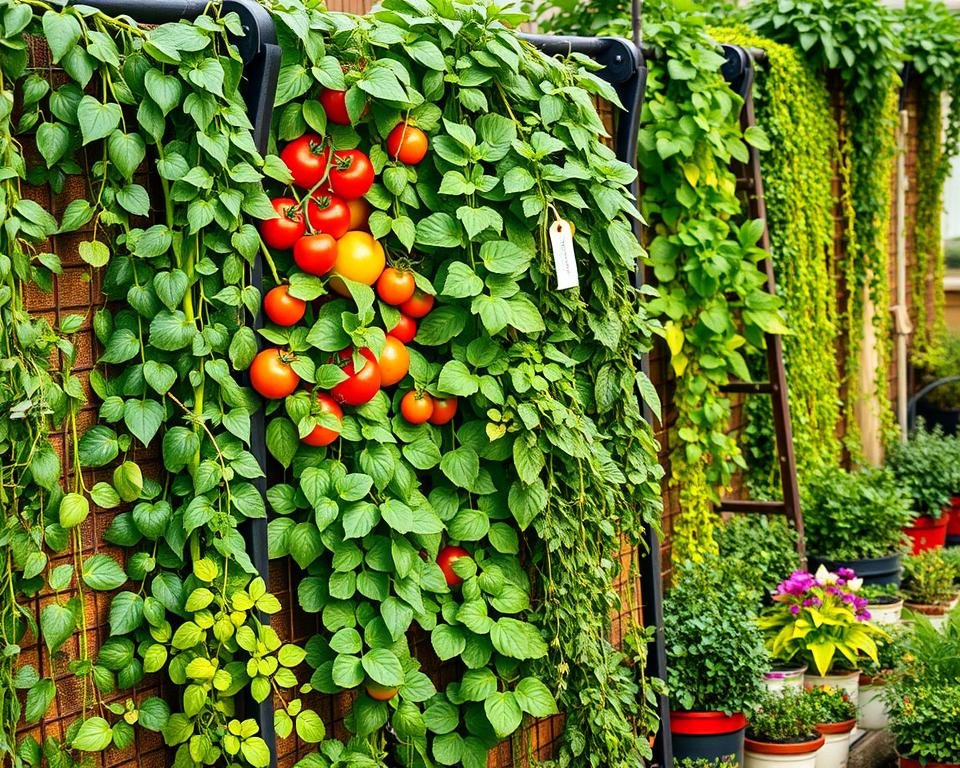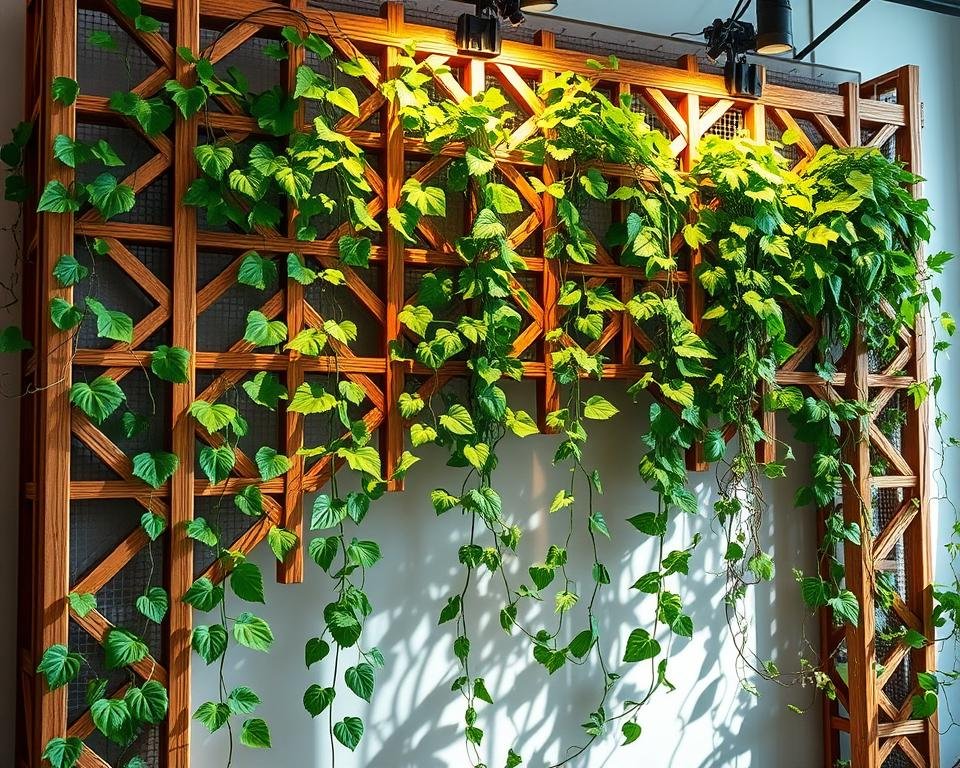Using Trellis Systems to Create Stunning Vertical Gardens
My garden story started with a small balcony and a big dream. I wanted a lush green space. Vertical gardening turned my balcony into a vibrant oasis. Trellis systems helped me use every inch of space.
Vertical gardening is changing the game for gardeners. It lets you grow more in less space. Trellis-systems save up to 80% of space compared to old ways. They’re perfect for city folks and anyone wanting more green.
Think about making a wall come alive with plants. Trellis-systems let you grow veggies, flowers, and herbs in tight spots. No matter the size of your space, vertical gardening makes it green and full of life.
Key Takeaways
- Vertical gardening saves up to 80% of traditional garden space
- Trellis-systems work in small urban and residential environments
- Supports diverse plant growth from vegetables to decorative plants
- Increases growing area with minimal ground footprint
- Transforms unused spaces into productive garden areas
Understanding Vertical-Gardens and Their Benefits
Vertical-gardens change how we garden, using space in new ways. They’re perfect for city folks, garden lovers, and anyone wanting more green in their life.
Vertical garden design brings nature indoors in a stylish way. It turns ordinary walls into beautiful, green spaces. This is great for small areas.
Space Optimization and Aesthetic Appeal
Your vertical garden support can turn plain walls into art. Here’s why it’s a game-changer:
- Increases plant density by up to 50% compared to traditional gardening
- Utilizes minimal ground space effectively
- Creates visually stunning green walls in both indoor and outdoor settings
Environmental Benefits and Air Quality
Vertical-gardens are more than pretty. They help the environment too:
- Reduce urban heat island effect
- Improve air quality by filtering pollutants
- Decrease water runoff by up to 90%
Accessibility and Maintenance Advantages
Vertical gardens make gardening easier and more fun:
- Reduces physical strain by minimizing bending and stooping
- Enables gardening in compact urban spaces
- Simplifies plant care and harvesting
“Vertical gardening transforms limited spaces into lush, productive green sanctuaries.” – Urban Gardening Expert
Vertical gardens are great for both new and seasoned gardeners. They solve space problems and add beauty.
Essential Components of Trellis Systems
Creating a successful vertical garden starts with knowing the key parts of trellis systems. The right structure is vital for plant growth and making the most of space.

- Sturdy support materials
- Mounting hardware
- Irrigation components
- Modular design options
When picking trellis systems, think about the structure you need. You can choose from:
- Freestanding frames
- Wall-mounted panels
- Modular expandable units
“The right trellis structure transforms vertical gardening from a challenge to an art form.”
Choosing the right materials is key for a lasting trellis system. Good options include:
| Material | Durability | Cost |
|---|---|---|
| Galvanized Steel | High | Medium |
| Aluminum | Medium | Low |
| Pressure-Treated Wood | Medium | Low |
Planning your vertical garden’s structure is crucial. Fasteners, planters, and irrigation systems are key for keeping plants healthy and your garden thriving.
Selecting the Perfect Location for Your Vertical Garden
Starting a vertical garden means picking the best spot. You need to know your space and the weather. With good planning, even a small area can become a lush green space.

Sunlight and Exposure Requirements
Most plants need 6 to 8 hours of direct sunlight each day. Check how much light your garden spot gets. South-facing walls get the most sunlight, perfect for veggies and herbs.
- Analyze sun patterns using a sun tracking app
- Observe shadows cast by nearby structures
- Consider partial shade options for sensitive plants
Wall and Support Structure Considerations
Your garden’s design needs strong support. Not all walls are good for gardens. Look at these things:
- Wall material durability
- Weight-bearing capacity
- Moisture resistance
- Potential for water damage
“The right vertical garden support transforms unused spaces into living, breathing ecosystems.” – Urban Gardening Experts
Space Assessment Guidelines
Use your space wisely to grow more. Vertical-gardens grow plants up, not out. This can make your garden up to 80% denser than regular gardens.
- Measure available vertical space
- Consider indoor and outdoor options
- Plan for drainage and water management
- Select compact plant varieties
By thinking about location, sunlight, support, and space, you’ll make a vibrant vertical garden. It will add life and beauty to any place.
Best Plants for Vertical Garden Success
To make a thriving vertical garden, picking the right plants is key. DIY gardeners can turn small spots into green oases. Choose plants that climb, cascade, and use space well.

When planning your vertical garden, think about these main plant types:
- Flowering Vines: Black-eyed Susan, cardinal climber, and moonflower add beauty
- Edible Climbers: Peas, pole beans, and cherry tomatoes are great for growing food
- Herbs: These small, versatile plants are perfect for vertical spots
“Vertical gardening transforms limited spaces into productive green environments” – Urban Gardening Expert
Sunlight is vital for a vertical garden’s success. Most veggies need at least six hours of direct sun a day. South-facing walls are the best for growing.
| Plant Type | Sunlight Needs | Space Requirements |
|---|---|---|
| Strawberries | Full Sun | Hanging Baskets |
| Lettuce | Partial Shade | Pocket Gardens |
| Cherry Tomatoes | Full Sun | Trellis Support |
Choose compact plants that grow well up. Stackable systems can hold up to 50 plants in just 4 square feet. They’re perfect for city gardeners with little space.
Design and Installation Techniques
Creating a successful vertical garden needs careful planning and design. Your trellis structure is key, offering support and beauty. Trellis systems can make small spaces look bigger, boosting vertical gardening by up to 50%.
Structure Assembly Methods
When designing your vertical garden, consider these DIY structure assembly techniques:
- Choose lightweight materials that can support plant weight
- Select sturdy anchoring points for maximum stability
- Plan for modular design to allow future expansion
Plant Arrangement Strategies
Strategic plant placement is key. Start planting from the bottom and work upward for a layered look. Pair heavy plants with strong supports for long-term success.
| Plant Type | Recommended Support | Weight Capacity |
|---|---|---|
| Lightweight Vines | Thin Wire Trellis | Up to 5 lbs |
| Heavy Climbers | Wooden Frame | 10-15 lbs |
| Mixed Varieties | Modular Metal Grid | 20+ lbs |
Anchoring and Support Systems
Proper anchoring prevents structural failure and protects your plants. Consider these design principles:
- Secure trellis to wall studs or solid surfaces
- Use adjustable mounting brackets
- Distribute plant weight evenly
A well-designed vertical garden is a marriage of functionality and aesthetic beauty.
Pro tip: Implement a honeycomb trellis structure to improve air circulation by 40% and promote healthier plant growth.
Irrigation and Maintenance Requirements
Keeping a vertical garden alive needs smart watering and regular upkeep. Your DIY setup must be well-thought-out to keep plants happy and healthy.
Watering is key for a thriving vertical garden. Each plant needs its own water schedule. Here are some effective ways to water:
- Drip irrigation systems for steady moisture
- Self-watering planters with built-in water tanks
- Manual watering for precise control
Pro tip: Vertical gardens often need more water because of wind and sun.
“Proper irrigation is the lifeline of your vertical garden’s health and productivity.”
Drainage is vital for your garden’s health. Make sure your setup has good drainage to avoid waterlogged soil and root rot. The CWC self-watering system is a great choice:
- Needs refilling up to four times less than regular watering
- Keeps plants watered for 2-4 weeks indoors
- Works with many pot types
Fertilizing is also important. Plants in vertical gardens need more nutrients because they have less soil. Use slow-release or liquid fertilizers that match your plants’ needs.
Regular care keeps your garden looking great. Set aside time for tasks like pruning, cleaning, and checking on your plants. This will help your DIY garden thrive for years.
Seasonal Care and Plant Management
Keeping your vertical garden healthy all year round needs careful planning. Your trellis systems must get regular checks to keep plants growing well. Knowing how to handle each season’s challenges is key to caring for your garden.
Spring and Summer Maintenance
In spring and summer, your garden needs a lot of care. Make sure to check your trellis systems often for any damage. Here are some important tasks:
- Checking support structures for stability
- Pruning overgrown plants
- Monitoring water requirements
- Applying balanced liquid fertilizer every 4-6 weeks
Fall and Winter Protection
When it gets colder, you must protect your garden. Different plants handle cold differently, so you need to adjust. Here are some ways to keep your garden safe:
- Mound soil around plant bases (6 inches deep)
- Use lightweight row covers to create microclimates
- Reduce nitrogen application to improve winter tolerance
- Inspect trellis systems for potential winter damage
Pruning and Training Guidelines
Pruning keeps your garden looking good and helps plants grow. Training plants on trellis systems makes them look better and grow more. Try to:
- Remove dead or diseased branches
- Train new shoots carefully
- Deadhead spent flowers to promote continued blooming
- Rotate plant locations seasonally
“A well-maintained vertical garden is a living artwork that evolves with each season.” – Garden Design Expert
Conclusion
Starting your vertical garden journey is a big step towards changing how we grow plants. Using new vertical garden support methods can change how we think about growing plants. Trellis systems help you use small spaces well and make beautiful views.
Vertical garden design is not just about looks. It helps city folks, balcony gardeners, and landscape lovers use their space better. With good planning, you can make gardens that look great and grow well, even in small areas.
Vertical gardening works in any space, big or small. It’s all about knowing your space, picking the right plants, and using strong support. This way, you can make a green haven that’s all your own.
Begin your vertical gardening journey now. Try out new designs and trellis setups. See how amazing growing plants up can be. Your green paradise is waiting – start changing your space, one plant at a time.







